From young, we have learnt that cells make up living things. Cells are the smallest building blocks of life and form larger living tissues and organs that make up the organism. Today, we will be discussing the cell theory, together with the different types of cells and organelles they have.
Cell Theory
First discovered by English scientist Robert Hooke in 1665, biologists have made their way to set out the cell theory. The cell theory is the basis that explains the reproduction and growth of living things. It states that:
- All living organisms are made up of one or more cells
- Cells are derived from pre-existing cells – existing cells divide via mitosis, meiosis, or binary fission to form new cells
- Cells are the smallest and most basic unit of life – cells can perform every vital physiological functions
Eukaryotes vs Prokaryotes
Cells are either eukaryotic or prokaryotic cells. Prokaryotes are unicellular organisms lacking membrane-bound organelles. They are often small, simple cells of 0.1 μm to 5 μm in diameter. On the other hand, eukaryotes are large and complex organisms of around 10 μm to 100 μm in diameter. They have membrane-bound organelles and are mostly multicellular organisms.
On top of the presence of membrane-bound organelles, prokaryotes lack a nucleus, instead bundling their DNA in the nucleoid region of the cytoplasm. Smaller DNA molecules (plasmids) are found around the cytoplasm Eukaryotes have their DNA stored in the nucleolus region of the membrane-bound nucleus.
Eukaryotes
There are three parts to a eukaryotic cell – the cell surface membrane, the nucleus, and the cytoplasm. The cytoplasm contains organelles, the cytosol, and the cytoskeleton.
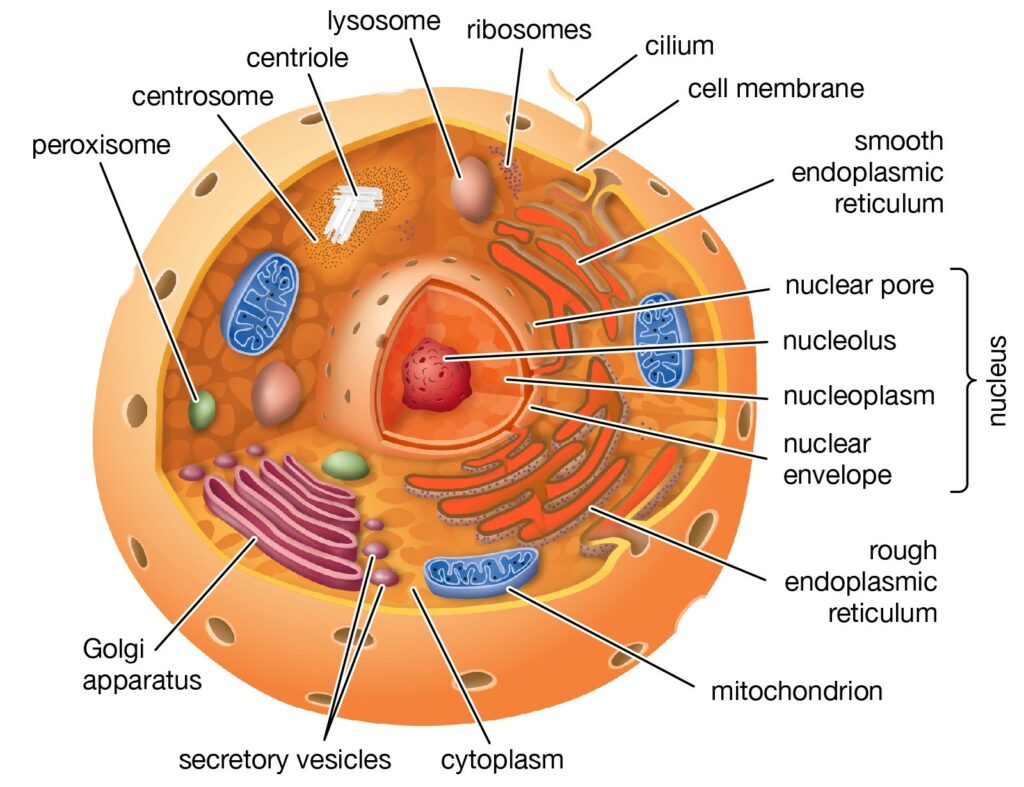
Cell Surface Membrane
The cell surface is a plasma membrane made up of glycolipids and glycoproteins. It has a bilayer structure due to the Fluid Mosaic model.
Nucleus
The largest organelle within the eukaryotic cell, the nucleus is an ovoid organelle bound by the nucleus envelope, a double membrane. The nucleus envelope has an outer membrane that is continuous with the endoplasmic reticulum, with nuclear pores that act as channels. These nuclear pores regulate the movement of substances in and out of the nucleus. The nucleus is filled with nucleoplasm.
The nucleus stores genetic materials that are necessary for the passing down of genetic information to the cell’s offspring. The genes in the nucleus are used as templates for the synthesis of proteins. On top of that, the nucleus is responsible for the activities within the cell through the expression of genes and the synthesis of proteins.
Nucleolus
The nucleus contains one or more nucleoli that contain the DNA of the cell. They are associated with histones and form chromatin threads that are highly condensed. The nucleolus is where ribosomal ribonucleic acid (rRNA) is transcribed and ribosomal subunits are assembled. The genes located in the nucleolus are also responsible for coding for rRNA.
Golgi apparatus
The Golgi apparatus is made up of a series of membranous sacs and tubules – the cisternae. Transport vesicles from the ER lumen fuse with the cis face of the Golgi apparatus, and secretory vesicles bud from the trans face.
The Golgi apparatus is responsible for chemically modifying, sorting, and packing proteins or lipids synthesised in the rER and sER, respectively. This helps to make the proteins and lipids specific to their function.
Lysosomes
Vesicles from the Golgi apparatus form lysosomes, which are small, spherical vesicles. They fuse with vesicles formed by endocytosis, releasing hydrolytic enzymes to digest the materials within the vesicles. Lysosomes also carry out autophagy – engulfing and digesting old and worn-out organelles. They are also responsible for the autolysis of the cell after cell apoptosis, digesting the contents within the cell.
Rough Endoplasmic Reticulum (rER)
The rER comprises interconnected cisternae. The rER is continuous with the outer membrane of the nuclear envelope, with ribosomes attached to the cisternae.
Protein synthesis and transport occur at the rER. The ribosomes on the cisternae synthesise the proteins before being sent to the membranes of the organelles, out of the cells, or into the lysosomes. These proteins are folded in the ER lumen before being packed into transport vesicles that bud off the surface of the rER.
Smooth Endoplasmic Reticulum (sER)
Similar to the rER, the sER is made up of cisternae, but without ribosomes attached. Lipids, such as hormones, are synthesised at the sER. On top of that, the sER is also responsible for detoxifying drugs and poisons and storing calcium ions needed for signal transduction and muscle contraction.
Chloroplast
Chloroplasts are large organelles bound by a double membrane found in plant cells. However, it has a third membrane, the thylakoid membrane, which forms a network of thylakoids. These thylakoids enclose the thylakoid space that is filled with fluids. That said, grana are formed when thylakoids are stacked and joined by intergranal lamellae.
Photosynthetic pigments like chlorophyll can be found in both the grana and the intergranal lamellae. Inside the chloroplast, the gel-like stroma contains circular DNA and several 70S ribosomes. Thus, chloroplasts are responsible for carrying out photosynthesis. Photosynthesis occurs on the thylakoid membrane, whereas the Calvin cycle occurs within the stroma.
Mitochondrion
Mitochondria are cylindrical organelles bound by a double membrane separated by an intermembrane space. The outer membrane is smooth and continuous, whereas the inner membrane folds extensively to form cristae projecting into the matrix.
The matrix is made up of circular DNA and several 70S ribosomes, like those seen in prokaryotes. The circular DNA and ribosomes allow proteins to be synthesised within the mitochondrion. Cellular respiration occurs in the mitochondria to produce ATP.
Centrioles
Centrioles are a pair of rod-like structures perpendicular to each other. They can be found at the centrosome, which is next to the nucleus. Centrioles are made up of nine triplets of microtubules, that are made up of tubulins. Animal cells have centrioles but not plant cells.
Centrioles are responsible for the nuclear division of animal cells, where it serves as the microtubule organising centres (MTOC) for spindle fibres to assemble. On the other hand, plant cells have microtubules that are well organised. As such, they do not need centrioles.
Ribosomes
Ribosomes are comprised of proteins and rRNA that are attached to the rER or are free in the cytosol. Eukaryotic ribosomes (80S) have two subunits – the large subunit of 60S and the small subunit of 40S. They are the site of protein synthesis and are often seen in clusters of polyribosomes. As such, simultaneous synthesis of multiple polypeptide chains from one mRNA can occur.
Cytoplasm
The cytoplasm refers to the space bounded by the plasma membrane of the cell. It contains the cytosol, cytoskeleton, and other organelles.
Cytosol
The cytosol is a fluid found in the cytoplasm. It contains ions, biomolecules and other organic compounds.
Cytoskeleton
The cytoskeleton is a framework of protein filaments that gives eukaryotes their shape. They also play a part in other cellular functions, such as the movement of vesicles around the cell.
Prokaryotes
On top of some of the organelles mentioned above, prokaryotes also have other organelles that are not present in eukaryotes.
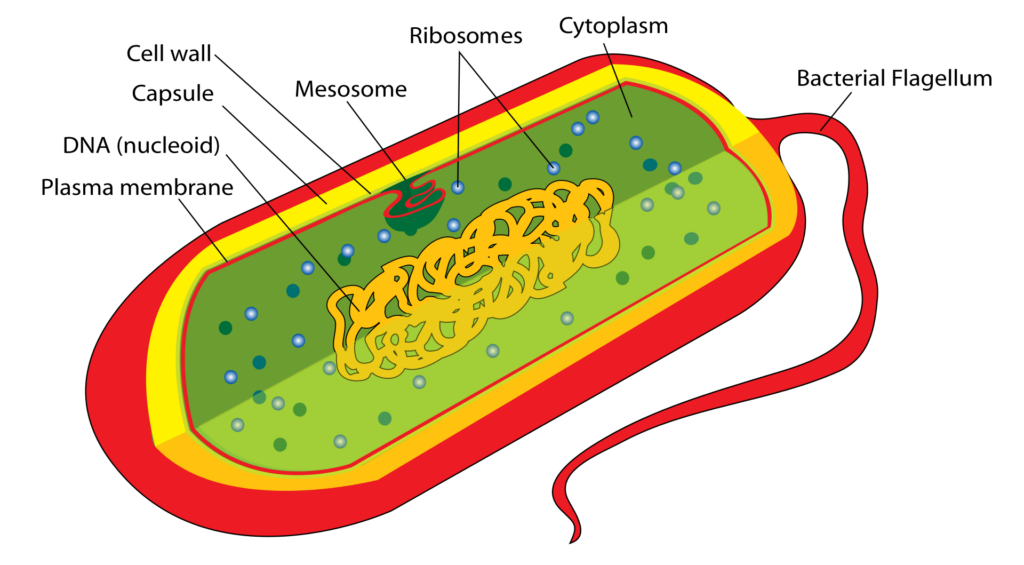
Peptidoglycan Cell Wall
All bacteria have a peptidoglycan cell wall that is made up of polysaccharide chains that are cross-linked by short amino acid chains. It helps to prevent the bacteria from bursting when too much water enters the cell. It is not necessary for biological functions but is beneficial for bacteria.
Flagellum
Flagellums are like tails that help bacteria move. Unlike in some eukaryotes, it rotates instead of beating in a wave-like motion.
Mesosome
During binary fission, the DNA attaches to the mesosome.
Pili
Pili helps bacteria to undergo conjugation in the variation of the prokaryotic genome.
Nucleoid Region
The nucleoid region comprises a single double-stranded circular DNA that is not associated with histones. It is not membrane-bound.
Other cell parts
Unlike in eukaryotes, the prokaryotic cell surface membrane does not have cholesterol. More proteins are found here as prokaryotes have fewer organelles to carry out cellular functions. It also contains the mesosome.
Unlike in eukaryotes, there is no complex compartmentalisation. This is due to the lack of membrane-bound organelles found in the cytoplasm of prokaryotes. 70S ribosomes can be found throughout the cytoplasm. However, unlike in eukaryotes, they consist of a 50S large subunit and a 30S small subunit.

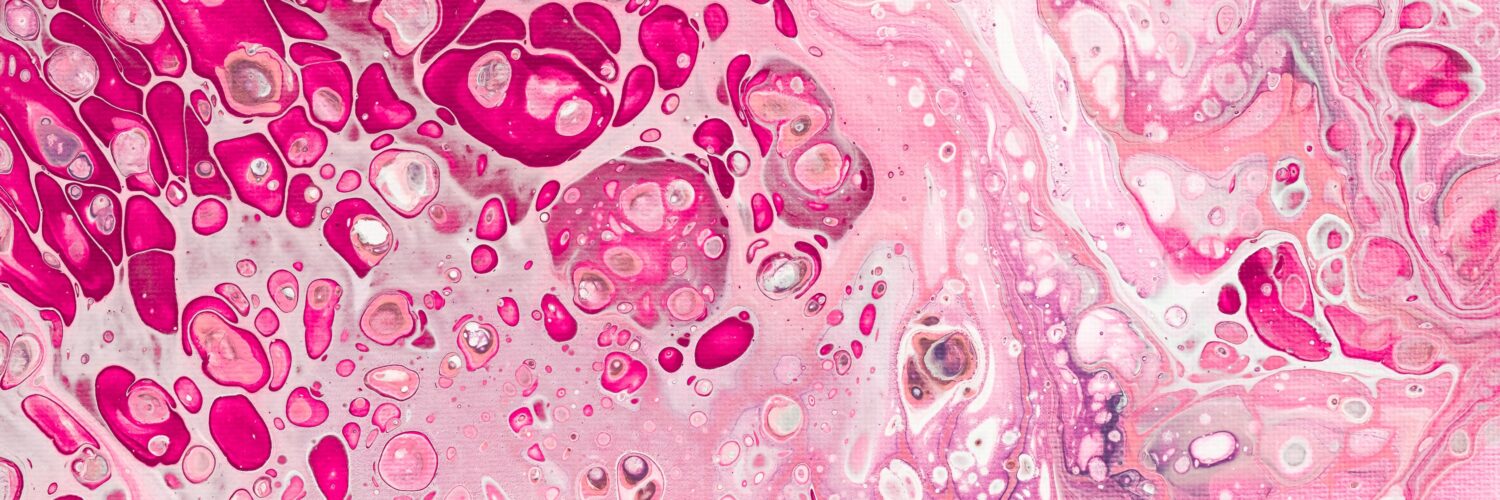

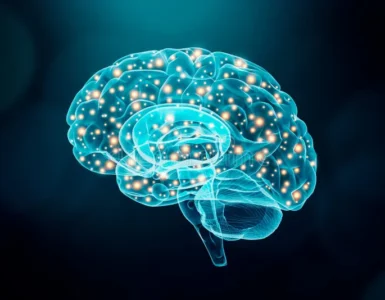
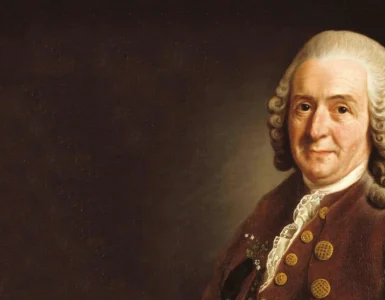
Add comment